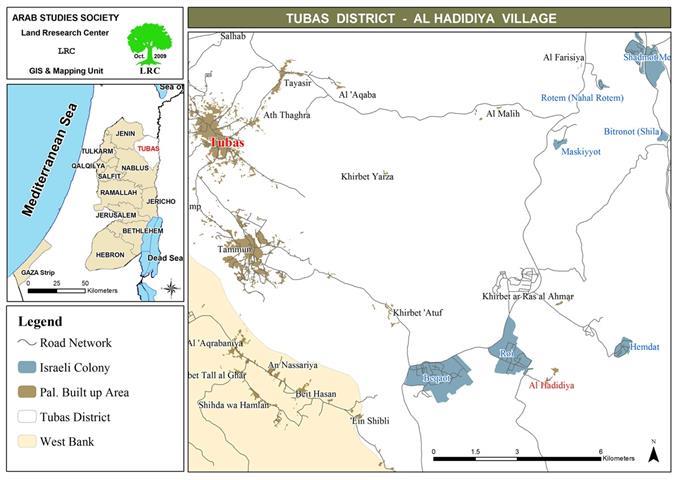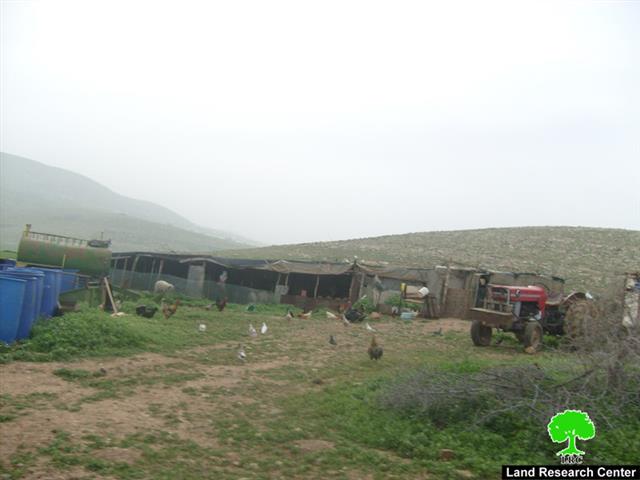Violation: eviction orders against a number of structures in Al Ras al Ahmar, Al Hadidiya, and Himsa.
Violators: the Israeli Occupation Army.
Victims: tens of farmers in the Northern Jordan Valley region.
Date: June 22, 2010.
Introduction:
The Jordan Valley region has been targeted by the Israeli conquerors since the Occupation of the West Bank in 1967. The nomad tribes inhabiting the area and living quite a simple life, a life that lacks the basic needs of modern life including water and electricity networks and public services, these people have been living a continuous threat of losing their homes and lands. The Israelis tend to cleanse the area from its Palestinian inhabitants rendering it ready for their colonial expansion plans.
The Israelis claim that these people, though simple and harmless, are threatening the Israeli colonies ‘security’, colonies that were built illegally on Palestinian lands and inhabited by immigrants who are placed there to fulfill Israeli colonial objectives. A claim that contradicts with the common sense considering the nomads lifestyle.

 Photos 1+2: Al Hadidiya overview
Photos 1+2: Al Hadidiya overview
The Violation:
On June 22, 2010, the Israeli Army handed a number of citizens military orders commanding them to leave the area they are living in within 24 hours, claiming that it is an ‘inaccessible military zone’; thus, depriving 125 people (including 79 children) from their residences. According to the Israeli Army, their stay there is against the Army instructions.
Victims of the Israeli Aggression:
|
No.
|
Victim
|
Location
|
Residential structures
|
Agricultural structures
|
Family members
|
children
|
|
1
|
Isma’el Abu Kibash
|
Himsa
|
6
|
2
|
18
|
11
|
|
2
|
‘Ali Abu Kibash
|
Himsa
|
2
|
3
|
11
|
5
|
|
3
|
Mohammad Abu Kibash
|
Himsa
|
4
|
4
|
14
|
8
|
|
4
|
Abdul Rahim Bisharat
|
Al Hadidiyya
|
3
|
2
|
27
|
19
|
|
5
|
Mohammad ‘Ali Bani Odeh
|
Al Hadidiyya
|
2
|
4
|
12
|
8
|
|
6
|
Mohammad Bani Odeh
|
Al Hadidiyya
|
2
|
4
|
10
|
4
|
|
7
|
Qayyad Salamin
|
Al Hadidiyya
|
3
|
2
|
15
|
9
|
|
8
|
Talib Bani Odeh
|
Al Hadidiyya
|
2
|
3
|
13
|
7
|
|
9
|
Ahmad Nawaj’a
|
Al Ras al Ahmar
|
2
|
5
|
11
|
8
|
|
Total
|
26
|
29
|
131
|
79
|
Abdul Rahim Bisharat, a 64-years-old cripple, has not been spared from the brutality of the Israelis; he grievely stated:’ I was born in this land more than 60 years ago, long before the Naksa (1967 conquest of the West Bank and Gaza). I spend my whole life in this land, however, the Israelis never left us to live in peace; many of my neighbors and relatives have left the area because they could not stand the Israeli continuous aggressions. Others were murdered by the Israeli troops or colonists. Al Ibqe’a plain which used to offer sufficient food to the nearby village has now become a war zone. Land mines, Israeli Army training grounds and outpost, and Israeli colonies cover most of the region. I have lost 4 houses during the last 5 years due to the Israeli extreme measures. Now, I have no idea where to go, my children and I have become homeless, again! I wonder if our simple houses have become a threat to the ‘Israeli state’. I believe not, they simply want to drive us out’.
He continued by saying:’ it does not matter how many houses we lose or how brutal the Israeli become; I told the Israeli Civil Administration Officers more than once that we will rebuild the houses you destroy, we are the owners of the land and you are the intruders, the land itself rejects you, you have no future in here’.
Al Hadidiyya and Himsa, a story of struggle:
It is not the first time that these nomads’ gatherings face such aggressions. In 2002, 320 people residing in the area were shocked to see Israeli dozers accompanied by the Israeli Civil Administration officers breaking into the area demolishing many simple houses that lacks the basic needs and services. They did not even give the owners the chance to clear out their luggage.
This happened twice during the year 2002, thus, forcing tens of citizens to leave the area and moving to the nearby Himsa. Also, the citizens filed an appeal in the Israeli Supreme Court demanding the immediate stoppage of the continuous demolitions.
The Court offered the owners an area of 91 dunums which they cannot exceed. This ‘compromise’ did not stop the day-to-day aggressions alongside the continuous distribution of the demolition orders which is believed that it will not stop as long as there are Palestinians residing in the area.
Picture 3: Al Hadidiya area a closed military
Origins of al Hadidiyya and Himsa:
The residents of Himas and Al Hadidiyya originated from the village of Tamoun near Tubas. Most of them belong to the Bisharat and Bani Odeh clans which were forced to leave for the sake of water before the Israeli conquest of the West Bank and Gaza. The resided in Al Ibqe’a plain and settled there herding and farming for living and living in simple houses. After 1967, the survival battle begun for those people.


















